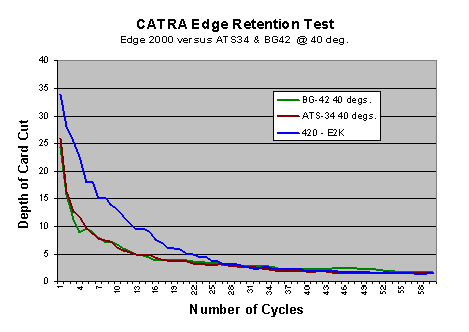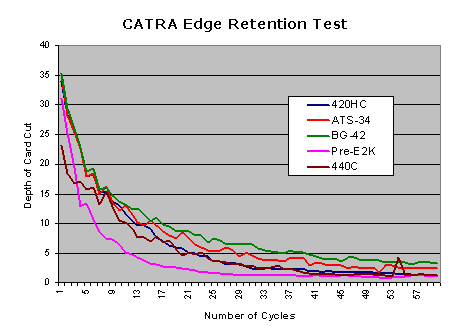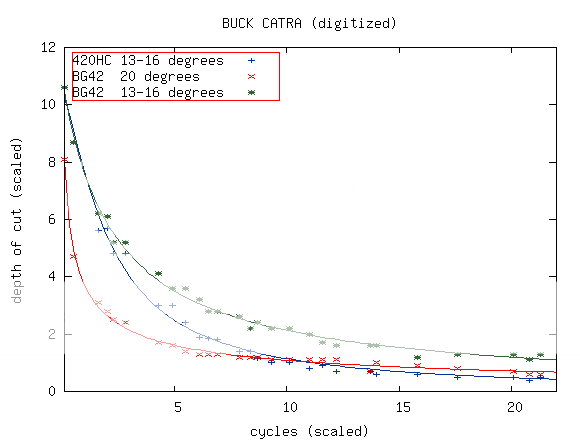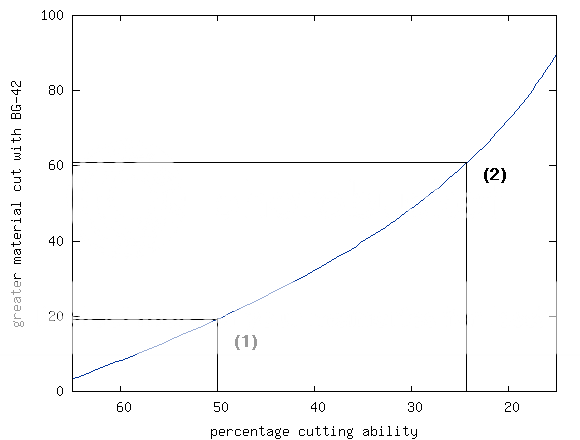Cliff Stamp
BANNED
- Joined
- Oct 5, 1998
- Messages
- 17,562
Recently I proposed how to model edge retention and showed a few examples of it in use :
http://www.bladeforums.com/forums/showthread.php?t=416896
http://www.bladeforums.com/forums/showthread.php?t=420917
Now for a harder question, can you model cutting ability? Under a specific amount of force can you predict how deep a blade cuts and how this changes with repeated cuts? Can you model this :

These are CATRA tests done by Buck knives to promote the Edge 2000 sharpening method. Buck reduced the angles from 35-50 degrees included to 26-32 degrees included and switched to a harder sharpening medium and thus removed the convexing of the cloth wheels. This work (2001) showed blades which cut better initially but cut better for longer. The effect of geometry was so significant that a 420HC blade with the flatter and more acute edge outcut both a ATS-34 and BG-42 blade with the older thicker convex edges. Now if you also re-profiled the BG-42/ATS-34 blades they would of course outperform the 420HC blade as shown here :

Now this had been known for years to those active on rec.knives and I had discussed it in detail in many reviews showing how changing the angle and as well the grit had the same effect. This was based on work by Swaim and Talmadge. Swaim had been doing it for years when I entered the discussions (lurking) in 1998. Now as to the model - cutting ability is basically inversely proportional to the force on the blade. Now ignoring friction (which is usually valid for several reasons) the force on a blade due to wedging is just a constant determined by the cross section which doesn't change during the cutting plus the force against the very edge which is essentially the bluntness which I have modeled before. Thus the cutting ability is then :
Where CA(x) is the cutting ability after a given amount of cuts in the test medium (x). CA_0 is the initial cutting ability with no blunting, which is a function of the stiffness of the media and the shape of the blade and initial sharpness. The constants b and c relate how and at what rate the blade blunts. These are the same coefficients as noted in the above linked posts as that part of the equation is of course the equation which I previously used to model sharpness. Ok, now does it work :

Those points are data digitized from the CATRA graphs which is why the axis are scaled (yes I could scale it back, there just isn't any point). The model replicates both early and late stage cutting ability. As noted eariler, Swaim predicted this behavior back in 1998 where he first noted his opposition of greater angles=better edge retention, one of many myths which still persist. I'll be using this model shortly to discuss the hemp cutting and other work I have done. I wanted to use a CATRA model first as it is completely independent data. I will also be using examples of other similar tools, like dental scrapers and such just to show the more general implications. Note I didn't quote the numbers that come out of the model in the above because I didn't have the raw data. I will have all of this for the data I have collected so I'll discuss some of the issues in more detail when I use that.
As a side note, the CATRA curves also show the self-sharpening effect which I first noted in late 1999 during work with Boye blades. The sharpness can decrease then rebound as the edge chips, wears smooth, and this pattern repeats. I had been meaning to look at these curves in more detail for awhile but got distracted with other work. Note in the above I modeled the force in a simple manner :
F_w+F_e
Or force due to wedging (F_w) plus force on the edge (F_e), you can actually break this up and model the force due to wedging in components and thus separate the effect of edge angle and thickness. You can also use this model to do something like compare the edge retention of two blades at different geometries because it is a multi-variable model which includes both geometrical and steel properties. Thus for example you could model the effect of different steels and geometries and thus predict how they would act at different angles or finishes. With a decent spread of steels over different properties (hardness, wear resistance, carbide size) you could also predict the exact properties needed in a steel to give the desired cutting abilities.
Once you have these two coefficients you can also calculate the ratio F_e/F_w which then tells you the fractional dependence of the edge retention on the cutting lifetime. This for example is very high for hemp but very low for soft woods. This shows that you can cut soft wood very well with a blunt blade because most of the force is due to wedging, but trying to cut hemp rope with a dull blade isn't productive. This is why for example makers trying hype blades will do something like cut up a coffee can and then slice wood showing the "superior" edge retention of the knife. In fact because the F_e/F_w ratio is so low for that media the test is nothing but hype. So as a side note, this also lets you quantify hype.
-Cliff
http://www.bladeforums.com/forums/showthread.php?t=416896
http://www.bladeforums.com/forums/showthread.php?t=420917
Now for a harder question, can you model cutting ability? Under a specific amount of force can you predict how deep a blade cuts and how this changes with repeated cuts? Can you model this :

These are CATRA tests done by Buck knives to promote the Edge 2000 sharpening method. Buck reduced the angles from 35-50 degrees included to 26-32 degrees included and switched to a harder sharpening medium and thus removed the convexing of the cloth wheels. This work (2001) showed blades which cut better initially but cut better for longer. The effect of geometry was so significant that a 420HC blade with the flatter and more acute edge outcut both a ATS-34 and BG-42 blade with the older thicker convex edges. Now if you also re-profiled the BG-42/ATS-34 blades they would of course outperform the 420HC blade as shown here :

Now this had been known for years to those active on rec.knives and I had discussed it in detail in many reviews showing how changing the angle and as well the grit had the same effect. This was based on work by Swaim and Talmadge. Swaim had been doing it for years when I entered the discussions (lurking) in 1998. Now as to the model - cutting ability is basically inversely proportional to the force on the blade. Now ignoring friction (which is usually valid for several reasons) the force on a blade due to wedging is just a constant determined by the cross section which doesn't change during the cutting plus the force against the very edge which is essentially the bluntness which I have modeled before. Thus the cutting ability is then :
Code:
CA(x)=CA_0/(1+b*x^c)Where CA(x) is the cutting ability after a given amount of cuts in the test medium (x). CA_0 is the initial cutting ability with no blunting, which is a function of the stiffness of the media and the shape of the blade and initial sharpness. The constants b and c relate how and at what rate the blade blunts. These are the same coefficients as noted in the above linked posts as that part of the equation is of course the equation which I previously used to model sharpness. Ok, now does it work :

Those points are data digitized from the CATRA graphs which is why the axis are scaled (yes I could scale it back, there just isn't any point). The model replicates both early and late stage cutting ability. As noted eariler, Swaim predicted this behavior back in 1998 where he first noted his opposition of greater angles=better edge retention, one of many myths which still persist. I'll be using this model shortly to discuss the hemp cutting and other work I have done. I wanted to use a CATRA model first as it is completely independent data. I will also be using examples of other similar tools, like dental scrapers and such just to show the more general implications. Note I didn't quote the numbers that come out of the model in the above because I didn't have the raw data. I will have all of this for the data I have collected so I'll discuss some of the issues in more detail when I use that.
As a side note, the CATRA curves also show the self-sharpening effect which I first noted in late 1999 during work with Boye blades. The sharpness can decrease then rebound as the edge chips, wears smooth, and this pattern repeats. I had been meaning to look at these curves in more detail for awhile but got distracted with other work. Note in the above I modeled the force in a simple manner :
F_w+F_e
Or force due to wedging (F_w) plus force on the edge (F_e), you can actually break this up and model the force due to wedging in components and thus separate the effect of edge angle and thickness. You can also use this model to do something like compare the edge retention of two blades at different geometries because it is a multi-variable model which includes both geometrical and steel properties. Thus for example you could model the effect of different steels and geometries and thus predict how they would act at different angles or finishes. With a decent spread of steels over different properties (hardness, wear resistance, carbide size) you could also predict the exact properties needed in a steel to give the desired cutting abilities.
Once you have these two coefficients you can also calculate the ratio F_e/F_w which then tells you the fractional dependence of the edge retention on the cutting lifetime. This for example is very high for hemp but very low for soft woods. This shows that you can cut soft wood very well with a blunt blade because most of the force is due to wedging, but trying to cut hemp rope with a dull blade isn't productive. This is why for example makers trying hype blades will do something like cut up a coffee can and then slice wood showing the "superior" edge retention of the knife. In fact because the F_e/F_w ratio is so low for that media the test is nothing but hype. So as a side note, this also lets you quantify hype.
-Cliff

